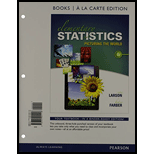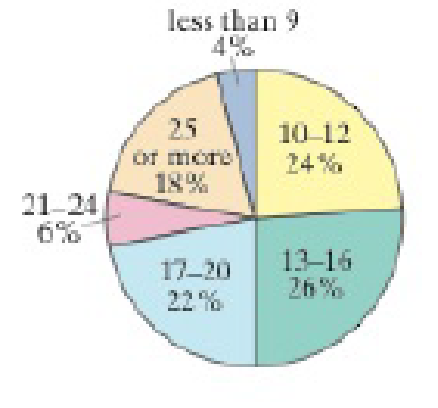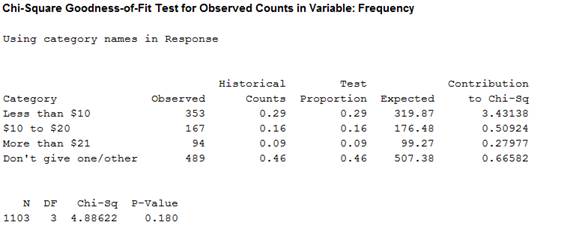
Concept explainers
In Exercises 1−4. (a) identify the claim and state H0 and Ha, (b) find the critical value and identify the rejection region, (c) find the chi-square test statistic, (d) decide whether to reject or fail to reject the null hypothesis, and (e) interpret the decision in the context of the original claim.
2. A researcher claims that the distribution of the amounts that parents give for an allowance is different from the distribution shown in the pie chart. You randomly select 1103 parents and ask them how much they give for an allowance. The table shows the results. At α = 0.10, test the researcher’s claim. (Adapted from Echo Research)
| Survey results | |
| Response | Frequency, f |
| Less than $10 | 353 |
| $10 to $20 | 167 |
| More than $21 | 94 |
| Don't give one/other | 489 |

a.
To identify: The claim.
To state: The hypothesis
Answer to Problem 10.1.1RE
The claim is that, the distribution of amounts differs from the expected distribution.
The hypothesis
Explanation of Solution
Given info:
The data shows the results of the distribution of the amounts that parent give for allowance.
Calculation:
Here, the distribution of amounts differs from the expected distribution is tested. Hence, the claim is that the distribution of amounts differs from the expected distribution.
The hypotheses are given below:
Null hypothesis:
Alternative hypothesis:
b.
To obtain: The critical value.
To identify: The rejection region.
Answer to Problem 10.1.1RE
The critical value is 6.251.
The rejection region is
Explanation of Solution
Given info:
The level of significance is 0.10.
Calculation:
Critical value:
The critical value is calculated by using the
Substitute k as 4 in degrees of freedom.
From the Table 6-Chi-Square Distribution, the critical value for 3 degrees of freedom for
Rejection region:
The null hypothesis would be rejected if
Thus, the rejection region is
c.
To obtain: The chi-square test statistic.
Answer to Problem 10.1.1RE
The chi-square test statistic is 4.886.
Explanation of Solution
Calculation:
Step by step procedure to obtain chi-square test statistic using the MINITAB software:
- Choose Stat > Tables > Chi-Square Goodness-of-Fit Test (One Variable).
- In Observed counts, enter the column of Frequency.
- In Category names, enter the column of Response.
- Under Test, select the column of Proportions in Proportions specified by historical counts.
- Click OK.
Output using the MINITAB software is given below:

Thus, the chi-square test statistic value is approximately 4.886.
d.
To check: Whether the null hypothesis is rejected or fails to reject.
Answer to Problem 10.1.1RE
The null hypothesis is fails to reject.
Explanation of Solution
Conclusion:
From the result of (c), the test-statistic value is 4.886.
Here, the chi-square test statistic value is lesser than the critical value.
That is,
Thus, it can be conclude that the null hypothesis fails to reject.
e.
To interpret: The decision in the context of the original claim.
Answer to Problem 10.1.1RE
The conclusion is that, there is no evidence to support the claim that the distribution of amounts differs from the expected distribution.
Explanation of Solution
Interpretation:
From the results of part (d), it can be conclude that there is no evidence to support the claim that the distribution of amounts differs from the expected distribution.
Want to see more full solutions like this?
Chapter 10 Solutions
Elementary Statistics Books a la carte Plus NEW MyLab Statistics with Pearson eText - Access Card Package (6th Edition)
- Consider a capital market with only two risky assets A and B. Their standard deviations are 1 and 2, respectively. There is no risk-free asset. When the correlation coefficient ρAB = 0, construct a portfolio, whose variance is strictly less than 1. [Hint: you may want to try the portfolio that puts more weight on the security with the lower standard deviation.]arrow_forward3. A researcher is testing a two-tailed null hypothesis at the p < .01 level with df = 45. What critical value would she or he use? Justify your answerarrow_forwardA major credit card company is interested in the proportion of individuals who use a competitor’s credit card. Their null hypothesis is H0: p=0.65H0: p=0.65, and based on a sample they find a sample proportion of 0.70 and a pp-value of 0.053. Is there convincing statistical evidence at the 0.05 level of significance that the true proportion of individuals who use the competitor’s card is actually greater than 0.65 ?arrow_forward
- 3. When you performed null hypothesis tests for two samples using a z-test, what can you conclude about the population growth rate of both samples under consideration if you rejected the null hypothesis?arrow_forwardA recent drug survey showed an increase in the use of drugs and alcohol among local high school seniors as compared to the national percentage. Suppose that a survey of 100 local seniors and 100 national seniors is conducted to see if the proportion of drug and alcohol use is higher locally than nationally. Locally, 65 seniors reported using drugs or alcohol within the past month, while 60 national seniors reported using them. Conduct a hypothesis test at the 5% level.NOTE: If you are using a Student's t-distribution for the problem, including for paired data, you may assume that the underlying population is normally distributed. (In general, you must first prove that assumption, though.) Part (a) State the null hypothesis. H0: plocal ≠ pnational H0: plocal > pnational H0: plocal = pnational H0: plocal < pnational Part (b) State the alternative hypothesis. Ha: plocal < pnational Ha: plocal = pnational Ha: plocal ≠ pnational Ha: plocal > pnational…arrow_forwardThe researchers hypothesized that people who view intelligence as highly stable will be more likely to overestimate their performance than those who view intelliegence as changeable. When testing that hypothesis, what is the outcome variable? a. The participants' scores on the antoymns test b. The participants' on the measure of their theories of intelligence c. The participants' estimates of their test performance relative to other test takers d. The participants' predictions of their scores on the antoymns testarrow_forward
- A certain financial services company uses surveys of adults age 18 and older to determine if personal financial fitness is changing over time. A recent sample of 1,000 adults showed 410 indicating that their financial security was more than fair. Suppose that just a year before, a sample of 1,200 adults showed 420 indicating that their financial security was more than fair. (a) State the hypotheses that can be used to test for a significant difference between the population proportions for the two years. (Let p1 = population proportion most recently saying financial security more than fair and p2 = population proportion from the year before saying financial security more than fair. Enter != for ≠ as needed.) H0: p1−p2=0 Ha: p1−p2!=0 (b) Conduct the hypothesis test and compute the p-value. At a 0.05 level of significance, what is your conclusion? Find the value of the test statistic. (Use p1 − p2. Round your answer to two decimal places.) Find the p-value.…arrow_forwardA certain financial services company uses surveys of adults age 18 and older to determine if personal financial fitness is changing over time. A recent sample of 1,000 adults showed 410 indicating that their financial security was more than fair. Suppose that just a year before, a sample of 1,200 adults showed 420 indicating that their financial security was more than fair. (a)State the hypotheses that can be used to test for a significant difference between the population proportions for the two years. (Let p1 = population proportion most recently saying financial security more than fair and p2 = population proportion from the year before saying financial security more than fair. Enter != for ≠ as needed.) H0: Ha: (b) Conduct the hypothesis test and compute the p-value. At a 0.05 level of significance, what is your conclusion? Find the value of the test statistic. (Use p1 − p2. Round your answer to two decimal places.) = Find the p-value. (Round your answer to…arrow_forwardSuppose a company claims that its market share is less than 16 percent, on average. Several of coworkers do not believe this, so a director decides to do a hypothesis test, at a 1% significance level, to persuade them. He conducts 21 surveys, collects the proper data, and works through the testing procedure: H0: μ≥16; Ha: μ<16 x¯=15.8 σ=1.8 α=0.01 (significance level) The test statistic is z0=x¯−μ0σn√=15.8−161.821√=−0.51 The critical value is −z0.01=−2.33. Conclude whether to reject or not reject H0, and interpret the results. Select the correct answer below: Reject H0. At the 1% significance level, the test results are not statistically significant and at best, provide weak evidence against the null hypothesis. Reject H0. At the 1% significance level, the data provide sufficient evidence to conclude that the mean market share is less than 16 percent. Do not reject H0. At the 1% significance level, the test results are not statistically significant…arrow_forward
- A consumer group is investigating a producer of diet meals to examine if its prepackaged meals actually contain the advertised 6 ounces of protein in each package. Assume the weights of all the prepackaged meals are normally distributed. Based on the following data, is there any evidence that the meals do not contain the advertised amount of protein? Run the appropriate test at a 5% level of significance. A. What are the appropriate hypotheses? B. What is the critical value(s) of the test? C. What is the test statistic? D. What is the decision rule using the critical values? E. What is the p-value of the test? G. What is your decision?arrow_forwardThe National Institute of Mental Health published an article stating that in any one-year period, approximately 9.5 percent of American adults suffer from depression or a depressive illness. Suppose that in a survey of 100 people in a certain town, seven of them suffered from depression or a depressive illness. Conduct a hypothesis test to determine if the true proportion of people in that town suffering from depression or a depressive illness is lower than the percent in the general adult American population. find the p valuearrow_forwardA recent drug survey showed an increase in the use of drugs and alcohol among local high school seniors as compared to the national percent. Suppose that a survey of 100 local seniors and 100 national seniors is conducted to see if the proportion of drug and alcohol use is higher locally than nationally. Locally, 67 seniors reported using drugs or alcohol within the past month, while 61 national seniors reported using them. Conduct a hypothesis test at the 5% level.NOTE: If you are using a Student's t-distribution for the problem, including for paired data, you may assume that the underlying population is normally distributed. (In general, you must first prove that assumption, though.) State the distribution to use for the test. (Round your answers to four decimal places.) P'local − P'national ~ ,arrow_forward
 MATLAB: An Introduction with ApplicationsStatisticsISBN:9781119256830Author:Amos GilatPublisher:John Wiley & Sons Inc
MATLAB: An Introduction with ApplicationsStatisticsISBN:9781119256830Author:Amos GilatPublisher:John Wiley & Sons Inc Probability and Statistics for Engineering and th...StatisticsISBN:9781305251809Author:Jay L. DevorePublisher:Cengage Learning
Probability and Statistics for Engineering and th...StatisticsISBN:9781305251809Author:Jay L. DevorePublisher:Cengage Learning Statistics for The Behavioral Sciences (MindTap C...StatisticsISBN:9781305504912Author:Frederick J Gravetter, Larry B. WallnauPublisher:Cengage Learning
Statistics for The Behavioral Sciences (MindTap C...StatisticsISBN:9781305504912Author:Frederick J Gravetter, Larry B. WallnauPublisher:Cengage Learning Elementary Statistics: Picturing the World (7th E...StatisticsISBN:9780134683416Author:Ron Larson, Betsy FarberPublisher:PEARSON
Elementary Statistics: Picturing the World (7th E...StatisticsISBN:9780134683416Author:Ron Larson, Betsy FarberPublisher:PEARSON The Basic Practice of StatisticsStatisticsISBN:9781319042578Author:David S. Moore, William I. Notz, Michael A. FlignerPublisher:W. H. Freeman
The Basic Practice of StatisticsStatisticsISBN:9781319042578Author:David S. Moore, William I. Notz, Michael A. FlignerPublisher:W. H. Freeman Introduction to the Practice of StatisticsStatisticsISBN:9781319013387Author:David S. Moore, George P. McCabe, Bruce A. CraigPublisher:W. H. Freeman
Introduction to the Practice of StatisticsStatisticsISBN:9781319013387Author:David S. Moore, George P. McCabe, Bruce A. CraigPublisher:W. H. Freeman





